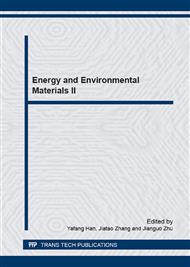p.91
p.96
p.101
p.107
p.113
p.118
p.125
p.132
p.137
Structure and Electrochemical Properties of La1-xBaxCoO3 Powders as Negative Electrode Materials for Ni/MH Batteries
Abstract:
The perovskite-type oxides have a newly application for alkaline batteries due to the excellent cyclic performance. In this work, La1-xBaxCoO3 (x = 0.2, 0.4, 0.6) powders were prepared by a sol-gel method as negative electrode materials for Ni/MH batteries, and their phase structure and electrochemical properties were investigated in details. The effect of Ba substitution on electrochemical kinetic properties, including the exchange current density I0 and the hydrogen diffusion coefficient D, of La1-xBaxCoO3 electrodes were also evaluated. X-ray diffraction analysis shows that La1-xBaxCoO3 (x = 0.2, 0.4, 0.6) perovskite-type oxides consist of two phases, La0.5Ba0.5CoO3 and BaCoO2.70. The discharge capacities of La1-xBaxCoO3 negative electrodes tested at 40 mAg-1 are 65.6, 76.6 and 88.3 mAhg-1 when x = 0.2, 0.4 and 0.6, respectively. Among the electrodes, La0.8Ba0.2CoO3 electrode has the highest discharge capacity retention ratio of about 87% after 50 cycles at room temperature.
Info:
Periodical:
Pages:
113-117
Citation:
Online since:
March 2015
Authors:
Price:
Сopyright:
© 2015 Trans Tech Publications Ltd. All Rights Reserved
Share:
Citation:


